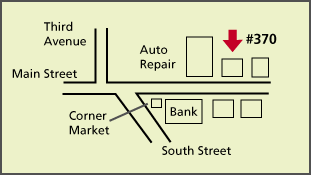

 TUTORIAL: SIGNS AND LANGUAGE
TUTORIAL: SIGNS AND LANGUAGEINTRODUCTION . ICON, INDEX AND SYMBOL . THE SEMIOTIC MODEL . DENOTATION AND CONNOTATION . PARADIGM AND SYNTAGM . ABSTRACTION . METAPHOR . METONYMY . MYTH
In some sense all signs are abstractions. Because a sign is not the object, but rather perceptual data that refers to the object, the perception of a sign does not provide all of the details that would have been provided by a perception of the object itself.
Some signs are especially abstract. For example, consider this map of the street on which I live.

If I send this map to my coworkers whom I've invited to dinner next week, I can reasonably expect that they will be able to find their way to my front door. In fact, in constructing this particular abstraction I have made a very specific choice of data based on my assessment of the information that would be needed by the people I've invited. Notice that the map does not include the name of the town, or compass markings. Because I know that everyone involved lives in town, I know that they do not need that information.
Context and convention are important when abstract signs are used in
communication. For example, as a reader, what did you take this syntagm to
mean ![]() ? That most people would interpret it as the
street number of a house
is an example of convention.
Similarly, because the word #bank# is used on a map, and because it is
enclosed within a rectangle, most readers would take it to refer to a kind of
building rather than to the bank of a stream, a bank of lights, or other
possible denotations of the term.
? That most people would interpret it as the
street number of a house
is an example of convention.
Similarly, because the word #bank# is used on a map, and because it is
enclosed within a rectangle, most readers would take it to refer to a kind of
building rather than to the bank of a stream, a bank of lights, or other
possible denotations of the term.
Next, suppose that I was to redraw the map to be used by my relatives who will be driving into town, but who have never been here before. In this case I might choose a higher degree of abstraction -- that is, I might leave out even more details in order to widen the scope of the map.
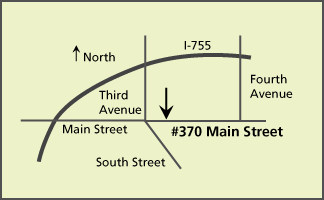
To have more abstraction means to have fewer details. In this case the area around my house, which was shown in detail in the first map, has vanished. But this map is more informative to my out-of-town relatives than the first map would have been because the first map would not have showed them how my house is situated relative to the main highway.
Finally, imagine that an air-conditioning service representative is coming to fix my heat-pump while I am away, and I need to send the company a map to show the representative how to find the machinery. In this case my map will be more detailed and less abstract.

As I add detail, the map becomes less symbolic and more iconic -- that is it comes more and more to be a picture instead of a set of symbols. In fact, many people might not call this last drawing a map at all.
This ability to reduce or increase detail in order to arrive at a level of abstraction that is appropriate to the information required is an essential characteristic of human communication. The next three sections will present three special categories of abstraction: metaphor, metonymy and myth.
But did she fly? Really?
In our experience, people don't fly, yet most readers will accept this sentence as making good sense. How does that come about? In semiotic terms, this situation is known as metaphor, and it occurs when signs with conflicting concepts overlap in a way that lets the reader accept them as simultaneously true. In this case the string of symbols that makes up the sentence invokes the concepts of women, of flying and of rooms.
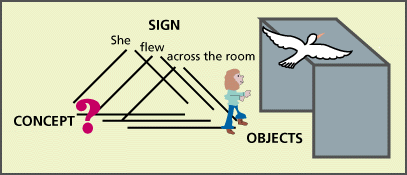
But what is the resulting final concept? Because the reader probably has had no prior experience with flying women (at least indoors), when his or her mind settles on a concept, it will be an imaginary one. In other words, the sign will be interpreted as referring to an unreal object. Thus, in semiotic terms, it is metaphor that opens up to humans the possibility of imagination.
Metaphors work paradigmatically. That is, a metaphor consists of a set of signs which point to objects that are not usually associated with one another. The person experiencing the metaphor must create a syntagm that brings to mind a concept compatible with the individual's prior experience. It is this act of uncertain creativity that gives the metaphor its imaginative power.
Instead, most U.S. readers will interpret the sign #White House# in this context as referring to the administrative apparatus of the United States government, and would make the assumption that the announcement was delivered by an administrative staff member speaking in the name of the President. Thus, the sign #White House# is taken to refer not to the house itself, but to the procedure by which official administrative announcements are made within the U.S. government.
Metonymy is particularly important in the semiotic study of mass communication. A television news show, for example, might present an image of new houses being built in one location to stand for a wholesale improvement in the national economy. Or, a newspaper photograph of a traffic accident might be used to represent the problem of "drunk driving."

When metonyms are used in this fashion, they act syntagmatically to produce an entire narrative from a single piece of the story. Confronted with an image of a smashed car, for example, the reader may construct the story of a driver who stopped at a bar after work for a drink, had too much to drink, failed to heed the warnings of friends, strayed across the center line of the highway and struck an oncoming vehicle.
Of course, the story that the reader constructs may not be true to the
particular accident being reported, but it will probably be similar, and it
will seem true to the reader. Thus, when metonym is used as a shorthand
method for
evoking a narrative, it becomes a valuable tool in the construction of mass
communication messages
![]() 1030
1030
The semiotic triangle shows the interaction among sign, concept and object as they relate to individuals.
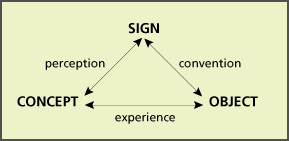
In Barthes' approach a myth is a chain of semiotic events which are encountered by the members of a society and which carry a meaning that, while shared, lies below the level of conscious understanding. Thus, the semiotic process itself becomes the sign in a "second order" process that operates simultaneously within the entire group.
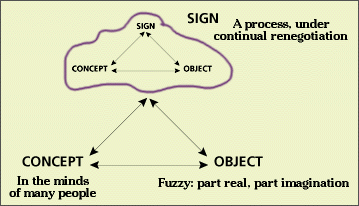
As an example, consider the following signs that might be encountered while driving to work: a US interstate highway sign, a large tank truck with the Exxon logo on its side, a sign above a Domino's pizza store, a US Postal Service mail box.

In US society each of these signs has a common, denotational meaning. Barthes' theory of semiotic myth suggests that the process by which these meanings are established is itself a sign whose meaning is shared among all of the members of the society, and which is likely to be subconscious.
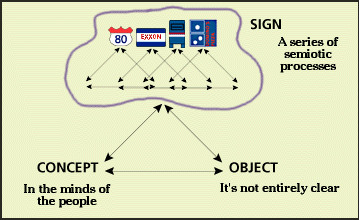
In this case the presence of the colors red, white and blue in each of the signs carries a cultural connotation of "United-Statesness." This connotation may not rise to the consciousness of any particular individual while he or she is encountering the mailbox, pizza store, and so on, but across the breadth of the society, it gives rise to shared meanings that may include notions of individuality, freedom, oppression, consumerism and the like.
The uncertainty as to the object of a mythical sign arises from the fact that the construction of the sign is ongoing. Societies constantly renegotiate their myths, and in fact, different subgroups of the same society may make very different mythical meanings from similar semiotic processes.